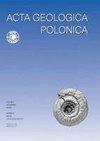高压高温条件下油气井注水的水文地球化学模拟
IF 0.9
4区 地球科学
Q3 GEOLOGY
引用次数: 2
摘要
从波兰的石油和天然气矿床中提取的大约80%的水通过注入岩石基质来处理。模型研究的目的是预测注入井中进行处理的水的水化学反应和储层形成中的水文地球化学过程。碳氢化合物地层的水文地球化学建模的目的也是确定地层水、注入水及其混合物沉淀和形成矿物沉积物的潜力,并确定对油井的腐蚀风险。为了评估饱和度指数和腐蚀率,使用了地球化学程序PHREEQC和井下SAT。水文地球化学建模结果表明,由于高压和高温(HPHT)的存在,地层水中的铁化合物(氢氧化铁Fe(OH)3和菱铁矿FeCO3)沉淀可能导致井和近井区发生堵塞。在整个测试压力和温度范围内,碳酸盐沉积物(方解石CaCO3、锶石SrCO3、菱镁矿MgCO3、菱铁矿FeCO3)从注入水中沉淀的确定性也很高。模型模拟表明,温度升高对矿物相沉淀潜力的影响比压力升高大得多。本文章由计算机程序翻译,如有差异,请以英文原文为准。
Hydrogeochemical modeling of water injection into an oil and gas well under high-pressure high-temperature (HPHT) conditions
Approximately 80% of water extracted from oil and gas deposits in Poland is disposed of by injection into the rock matrix. The aim of the model research was to predict both the hydrochemical reactions of water injected into wells for its disposal and the hydrogeochemical processes in the reservoir formation. The purpose of hydrogeochemical modeling of the hydrocarbon formation was also to determine the potential of formation waters, injection waters, and their mixtures to precipitate and form mineral sediments, and to determine the corrosion risk to the well. In order to evaluate saturation indices and corrosion ratios, the geochemical programs PHREEQC and DownHole SAT were used. The results of hydrogeochemical modeling indicate the possible occurrence of clogging in the well and the near-well zone caused mainly by the precipitation of iron compounds (iron hydroxide Fe(OH)3 and siderite FeCO3) from the formation water due to the presence of high pressures and temperatures (HPHT). There is also a high certainty of the precipitation of carbonate sediments (calcite CaCO3, strontianite SrCO3, magnesite MgCO3, siderite FeCO3) from the injection water within the whole range of tested pressures and temperatures. The model simulations show that temperature increase has a much greater impact on the potential for precipitation of mineral phases than pressure increase.
求助全文
通过发布文献求助,成功后即可免费获取论文全文。
去求助
来源期刊

Acta Geologica Polonica
地学-地质学
CiteScore
1.70
自引率
18.20%
发文量
0
审稿时长
>12 weeks
期刊介绍:
Acta Geologica Polonica publishes original and review papers on all aspects of basic geology, with particular focus on sedimentology, stratigraphy, palaeontology, regional geology, structural geology, and regional petrography. All papers are published in English.
 求助内容:
求助内容: 应助结果提醒方式:
应助结果提醒方式:


